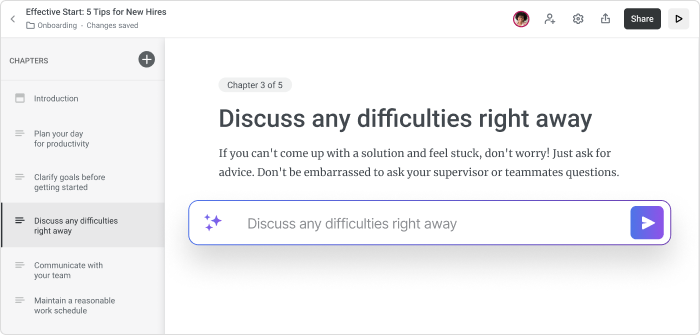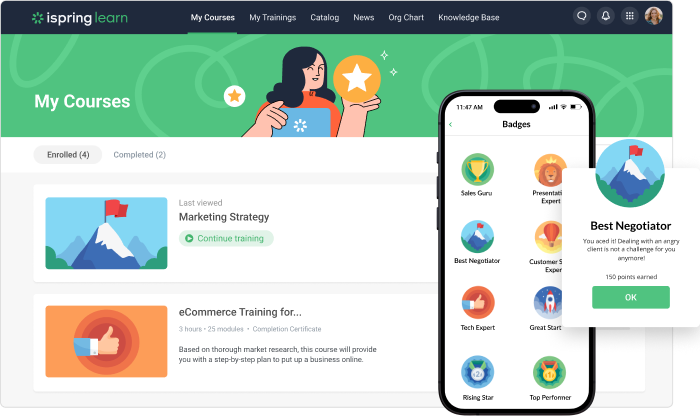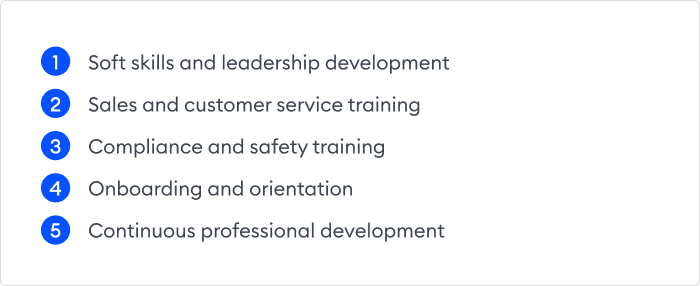9 eLearning Trends in 2026 for L&D Experts and Educators

eLearning is a dynamic industry that boasts big technological advancements and innovative approaches – and this year has been no exception. Educators and L&D experts are constantly on the lookout for new tendencies, strategies, and tools. This helps them adjust their approach and keep up with the changing requirements of learners and organizations, and create top-notch training programs.
As we step into 2026, it’s time to take a look at key trends in learning and development. We’ll explore what’s going to be the new black in the industry and cover the new trends’ major implications. Keep reading to learn more!
Overview of the Top 9 Key eLearning Trends in 2026
So, let’s gaze into the crystal ball and see the future of learning and development in 2026. These 9 trends are already taking center stage in the eLearning industry and will keep influencing the ways that L&D specialists, trainers, and instructional designers approach their work.

1. AI-powered learning
Artificial intelligence (AI) is everywhere, and it’s no wonder why this technology quickly found itself useful in online learning. Thanks to AI, we can now create learning content faster, build personalized learning experiences, and get more accurate insights into learner progress via AI-powered analytics.
The branch of AI that has an especially big impact on L&D is machine learning (ML). This approach uses data and algorithms to learn from repeated human inputs, which improves the quality and accuracy of AI-generated content over time. Coupled with natural language processing and generation, ML paves the way for all the tools that we have now become so accustomed to using, including ChatGPT.
Many eLearning platforms are actively embracing the trend and incorporating AI into their interfaces. iSpring Page, for example, recently added iSpring AI to its feature set. You can ask the AI assistant to suggest course ideas, write content, and even improve an online course design.

2. Virtual reality (VR) and augmented reality (AR)
Virtual reality enriches learning by offering simulations that provide virtual hands-on training in realistic environments. This is the most immersive technology out there (after all, full immersion is what it was designed for), so it’s perfect for engaging learners in real-life scenarios, boosting interactive training, and improving experiential learning. VR and AR can spice up otherwise dull corporate training programs and take the learning experience to the next level.
Many organizations that want to improve their employee training programs and learning protocols still avoid VR and AR because they see them as costly and difficult to implement. However, you can make the most of this technology without buying an expensive pair of VR glasses for every learner or trainee. Leverage 360 videos, use mobile-based VR apps, or create designated spaces equipped with VR technology in your office.
3. Gamification
Gamification is not a new concept, but it continues to be a major L&D trend. Using motivational game mechanics, such as points, badges, and leaderboards, is a proven recipe for maximizing employee engagement. The logic is simple: when you incentivize learners with fun competition and rewards, you inspire a sense of achievement and the ability to visualize one’s own progress, encouraging continuous learning and participation.

Gamification is not just about friendly competition between colleagues in corporate training. You can enrich the learning experience through gamified scenarios and simulations that help learners develop problem-solving skills. Implement role-plays, dialogue simulations, and other interactions in corporate training courses to encourage your team to apply knowledge and make informed decisions.

4. Data-driven instructional design
It’s safe to say we’re now living in a data-driven world. We analyze, process, and parcel it to gain insights into the best courses of action. Instructional design can also now benefit from data analytics to track employee progress, identify trends, and evaluate levels of engagement.
Since data analytics is fully automated, thanks to modern eLearning software, L&D specialists and educators can receive constant data updates and see how their learning programs and approaches are working in real time. For example, a course creator can assess the real-time feedback and performance indicators of an ongoing training program and adapt their methods based on the identified areas that need improvement.
Besides, data analytics help educators provide personalized recommendations to individual learners. It becomes easier to give targeted guidance and address the specific strengths and weaknesses of each team member. This approach guarantees a supportive learning environment and the growth of relevant skills.
5. Mobile learning
Mobile learning offers flexibility, accessibility, and convenience. And given that we now spend hours a day looking at our smartphone screens, mLearning is a natural trend that learners quickly embraced. With a fast-running app, your learners can access educational content at any time and from any location.

Another huge benefit of mobile learning is the possibility of offline training. This is especially useful for employees working in remote locations or areas with limited internet connectivity. It’s also perfect for self-paced learning since it allows individuals to progress through the training materials at their own speed and based on their schedule.
6. Multimodal Learning
Let’s be honest, no one enjoys looking at plain slides with dull text. It’s not only boring but also inefficient. Monotonous content prevents enhanced learner engagement and knowledge retention. That’s exactly why multimodal learning has become a major L&D trend: using various modes of content delivery makes the learning experience more diversified and interactive. It also acknowledges that learners have varied preferences, strengths, and styles.
The more formats and types of media you use in course content, the better. It can include text, images, videos, audio, simulations, and interactive elements. When combined and structured in a smart way, these formats guarantee a dynamic learning pace and deeper involvement in the learning process.
7. Social learning platforms
Teamwork makes the dream work, remember? Social learning platforms like iSpring LMS have emerged as convenient hubs for communication-based education and effective team collaboration. A social learning platform is more than a centralized digital location for training materials and course distribution. It provides functionalities for learner interaction, collaboration, and community building.
Social learning platforms offer such features as interactive whiteboards, live chat functionalities, and real-time co-editing tools. So even if you work with remote or hybrid teams, trainees can easily stay in touch, work together, and feel a sense of belonging to a group.
8. Conversational AI chatbots and voice assistants
Conversational AI chatbots engage with learners in real time and can provide instant help, answer queries, or offer tailored guidance. This is a great feature for those organizations and educators that work with multiple learners and simply don’t have the capacity to provide personalized support to each individual.
While chatbots and voice assistants can’t fully replace a human mentor or trainer, they help trainees navigate many aspects of the learning process. The bots use natural language processing to adapt to individual needs and communication styles quickly, creating a more interactive and personalized learning experience.
9. Blockchain technology
Blockchain technology may be a surprising item on this list of trends; many people associate this technology with finance and cryptocurrency rather than eLearning. However, blockchain has found its use in L&D, particularly thanks to providing data security and credential verification in education. In other words, blockchain helps ensure the safety and legitimacy of educational records like degrees and certificates. This technology makes it harder to fake credentials and allows people to share their achievements securely.
Additionally, it’s used to create decentralized learning platforms for sharing educational content and transactions. Thanks to blockchain, platforms become more secure as they don’t rely on a single authority, making it harder for data to be altered or hacked. This is an enormous advantage, especially for those organizations that deal with sensitive data in the learning process.
eLearning Programs That Most Benefit From New Learning and Development Trends
We’ve listed 5 major types of L&D areas that can make the most of the hot trends in the eLearning industry with detailed explanations below.

Soft skills and leadership development
Social learning platforms are a key feature of modern eLearning. They create spaces where learners can collaborate, have discussions, share their experiences, and collectively improve their soft skills. The collaborative aspect also applies to immersive technologies, such as virtual and augmented reality.
These technologies offer simulated leadership challenges and interactive scenarios, allowing learners to practice and improve their decision-making, communication, and team management skills in a safe-to-fail virtual environment.
In addition, the rise of AI-powered personalization in eLearning guarantees a customized approach to enhancing soft skills. These platforms customize the content to meet specific developmental needs, allowing learners to embark on a personalized learning journey that caters to their individual requirements.
The interactive nature of eLearning trends not only enhances soft skills training but also ensures that future leaders will be equipped with the versatile interpersonal skills required in the workplace.
Sales and customer service training
To learn all the ropes of effective communication with leads and clients, sales reps can engage in real-life agent-customer situations through role-plays and AI-generated branching scenarios. This way, trainees can test their communication, negotiation, and product knowledge skills.
For example, role-play activities can revolve around practicing cold calls, handling objections during sales presentations, or conducting follow-up conversations to nurture leads effectively. This type of training will prepare sales agents for real interactions with customers and provide them with rock-solid communication protocols.
Sales teams will also benefit from social learning platforms where they can exchange valuable insights and strategies that work for them or share successful sales cases with fellow employees. This builds a culture of constant improvement, collaboration, and skill enhancement within the organization.
Compliance and safety training
Compliance training is typically the least engaging type of learning because it often involves dense, jargon-heavy content that can be dry and monotonous for learners. However, you can make it more involving thanks to gamification elements, such as interactive scenarios and simulations. Learners can also navigate through realistic scenarios via VR technology, applying compliance protocols in a simulated environment. This improves practical understanding and boosts knowledge retention.
Mobile learning is also a great asset for effective compliance training. It allows employees to engage with compliance materials at their convenience, whether during breaks or while commuting. For instance, employees can access bite-sized compliance modules that include quizzes, case studies, or interactive videos. With all the essential training materials at their fingertips, trainees can go back to review specific modules or reference crucial information as needed.
Onboarding and orientation
Onboarding is an employee’s first step toward integrating into a new role, understanding the company’s culture, and becoming productive within the organization’s environment. That’s why new hire training should be comprehensive, well-structured, and engaging.
To make sure that new employees – especially those working remotely – feel welcome in the organization, you can use VR to give them a virtual company tour. Don’t forget to set them up on an LMS that has social learning capabilities in order to establish contacts with colleagues. Providing AI assistance in the form of a conversational AI chatbot can be a great addition to a human mentor: new hires can use it to solve simple queries or navigate through initial training materials and company policies.
Organizing onboarding into a multimodal training program is also a winning strategy. New hires will have an easier time grasping information because it’s presented in a variety of formats, from slides and longreads to videos and interactions. During the onboarding process, L&D specialists or HR managers can use data-driven analytics to see how new employees are coming along in their training and determine major areas of their professional improvement from the get-go.
Continuous professional development
Continuous employee learning and development is now a necessity rather than a luxury, especially for growing organizations that want to scale and expand. Whether it’s technical skills, soft skills, industry knowledge, or adapting to new technologies, fostering ongoing learning ensures that employees remain agile and adaptable. Luckily, the new L&D trends make lifelong learning much easier.
Module-based mobile learning definitely takes the lead here: it presents content in an easily digestible format and allows trainees to engage in continuous skill enhancement without disrupting their busy schedules. This approach ensures that learning is ongoing and accessible.
Continuous skill development programs can also benefit from AI-powered personalization. By analyzing trainees’ preferences, learning styles, and growth areas, AI algorithms can offer targeted content suggestions and customized learning paths.
Best Practices for Implementing New L&D Trends
New L&D trends in 2026 focus on embracing personalized, engaging, and adaptable learning methods. By taking advantage of them, organizations can level up their training protocols and spark meaningful professional growth for every employee or team member.
However, adopting these eLearning trends blindly or trying to squeeze them all into a single online learning program is not the smartest way to reap the benefits. That’s why we’ve collected some of the best practices that will help you implement them wisely to maximize learning and training ROI.
1. Conduct a comprehensive skills assessment
Before you even decide on which trends you want to try out, conduct a comprehensive skills assessment throughout your organization. This is a reliable way to create a clear map of your teams’ existing skill sets, evaluate the skills required for future growth, and recognize any areas that need improvement to bridge this gap.
In other words, skills assessment lays the groundwork for customizing your L&D programs. Once you know what areas to target, you’ll have a better idea of which eLearning trends will come in handy for achieving your specific goals.
2. Align L&D with organizational goals
Learning for the sake of learning is not something many organizations can (or have to) afford. Remember that implementing new eLearning technologies and strategies needs to align with the overall strategic goals of the organization and deliver tangible results. This way, the skills that trainees gain through training will directly contribute toward sustained business growth, meeting industry demands, and achieving other long-term objectives.
3. Establish key performance indicators (KPIs) for learning
Define measurable KPIs to track the effectiveness of L&D programs. This will allow you to analyze and compare how newly implemented strategies affect the overall impact of your training protocols.
You can monitor employee performance, engagement levels, and the application of learned skills in real-world scenarios. It’s important to evaluate these L&D KPIs regularly and make necessary adjustments based on the results to stay agile and sustain growth.
4. Create a scalable learning infrastructure
Build a scalable infrastructure that can accommodate your learning and training needs. This includes a robust learning management system (LMS), adaptable content delivery mechanisms for multimodal learning, and the ability to integrate new technologies seamlessly.
5. Don’t be afraid to employ new learning technology
Some organizations may want to play it safe and stay away from newer, less familiar innovations like VR. However, using them in employee training can make learning more exciting and effective. For instance, imagine using VR to simulate real-life customer service scenarios for employees. This immersive experience fosters knowledge retention and skill growth much more efficiently than, say, reading scripted interactions from dull slides.
Bottom line: Embrace new technologies that offer realistic simulations for practical training. It may seem like an unnecessary or costly addition to your learning assets, but it’s definitely a worthwhile investment.
6. Prioritize personalized learning paths
The days of one-size-fits-all training protocols are gone. Employees want to engage in adaptive learning that reflects their professional goals. To meet this need, use data-driven analytics to implement personalized learning trajectories for individual trainees. Based on current employee performance, content format preferences, and learning styles, AI can help you deliver targeted programs that speed up the skill development process for each learner.
7. Seek employee feedback and involvement
Actively involve employees in the L&D process by inviting their feedback and insights. You can do this through regular surveys or one-on-one interviews with trainers or HR departments. By engaging in dialogue with trainees, you’ll be able to understand their experiences with new eLearning formats and strategies and see what solutions work best for your organization. Employees’ perspectives on eLearning trends that have been adopted are also key to improving the overall design of your L&D programs.
The Limitations of New eLearning Trends
Although the future of eLearning seems bright, new L&D trends still have potential limitations that are worth taking into account. They include the following:
1. The lack of personal interaction
As we move from physical on-site learning towards online and blended learning protocols, valuable live face-to-face interactions are inevitably lost in the process of this transition. The lack of this active social element, which brings so much engagement to traditional classroom settings, cannot yet be fully replicated via new eLearning technology.
Even when virtual and augmented reality are involved, learners might still feel the need for more authentic and spontaneous human interactions to grow their interpersonal communication skills and develop emotional intelligence.
2. Continuous need for eLearning software maintenance and updates
New L&D trends rely heavily on digital platforms and solutions. While eLearning SaaS, such as LMSs, authoring tools, or learning experience platforms (LXPs) are a total must for modern agile learning, they require continual maintenance and updates. These processes can disrupt the usual flow of operations within an organization and sometimes cause temporary interruptions in learning activities or access to training materials.
3. Resistance to change
It’s almost impossible to constantly keep up with all the innovations the eLearning industry offers educators and learners. And remember, people are creatures of habit. That’s why some organizations and teams may resist these new approaches or find adapting to fresh L&D technologies and methodologies to be challenging. This can be a big barrier to the successful implementation of new eLearning trends.
Final Thoughts
2025 is drawing to a close, but 2026 offers lots of exciting opportunities to make your eLearning journey even more effective and impactful. Experiment with the hot trends, test new L&D software, and seek solutions that bring the most value to your learners.
If you feel confused and don’t know how to start leveraging eLearning innovations, don’t worry because iSpring always has your back! Explore our blog articles for useful tips and practices, and stay tuned for new useful content in the upcoming year!



